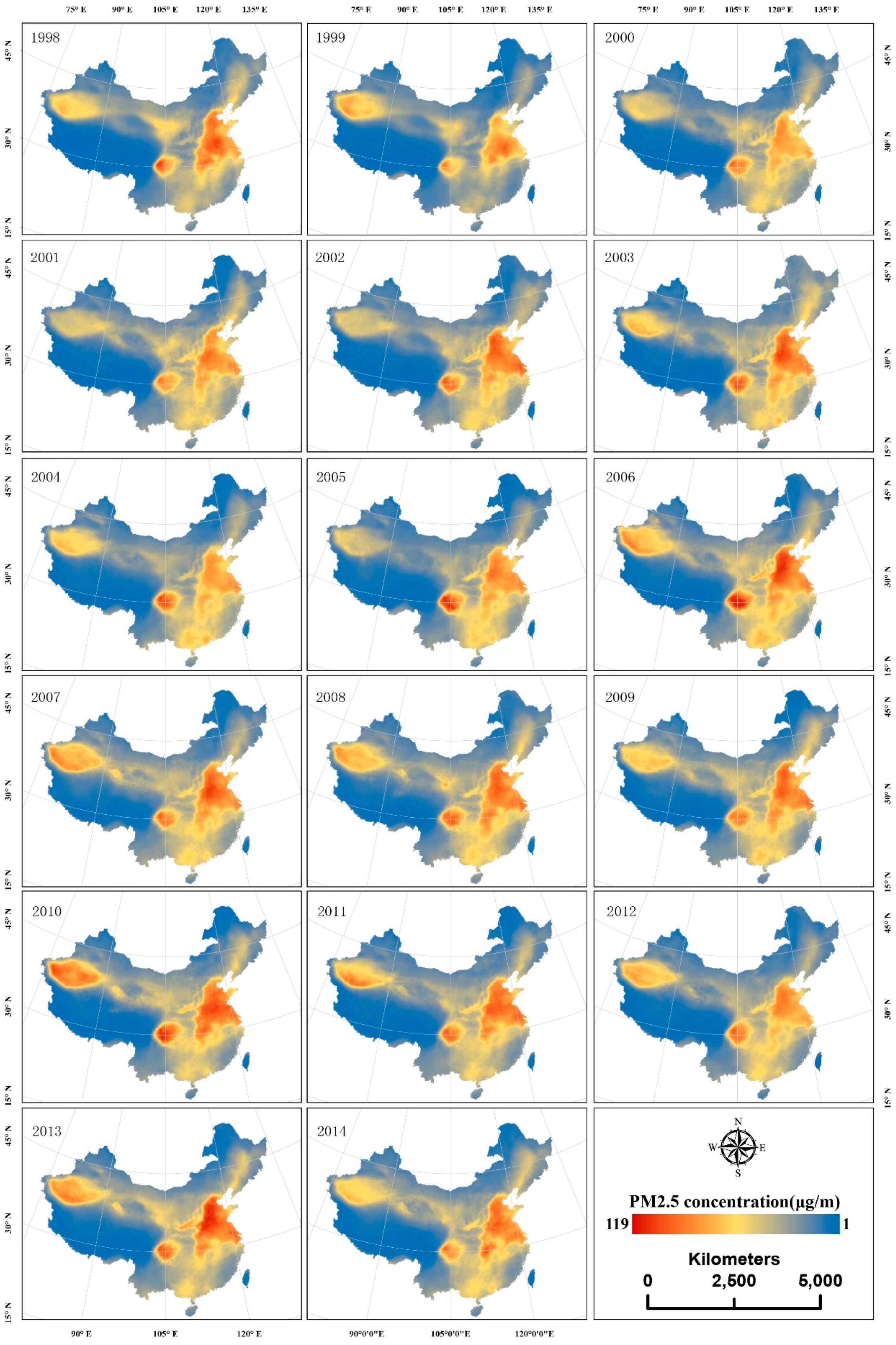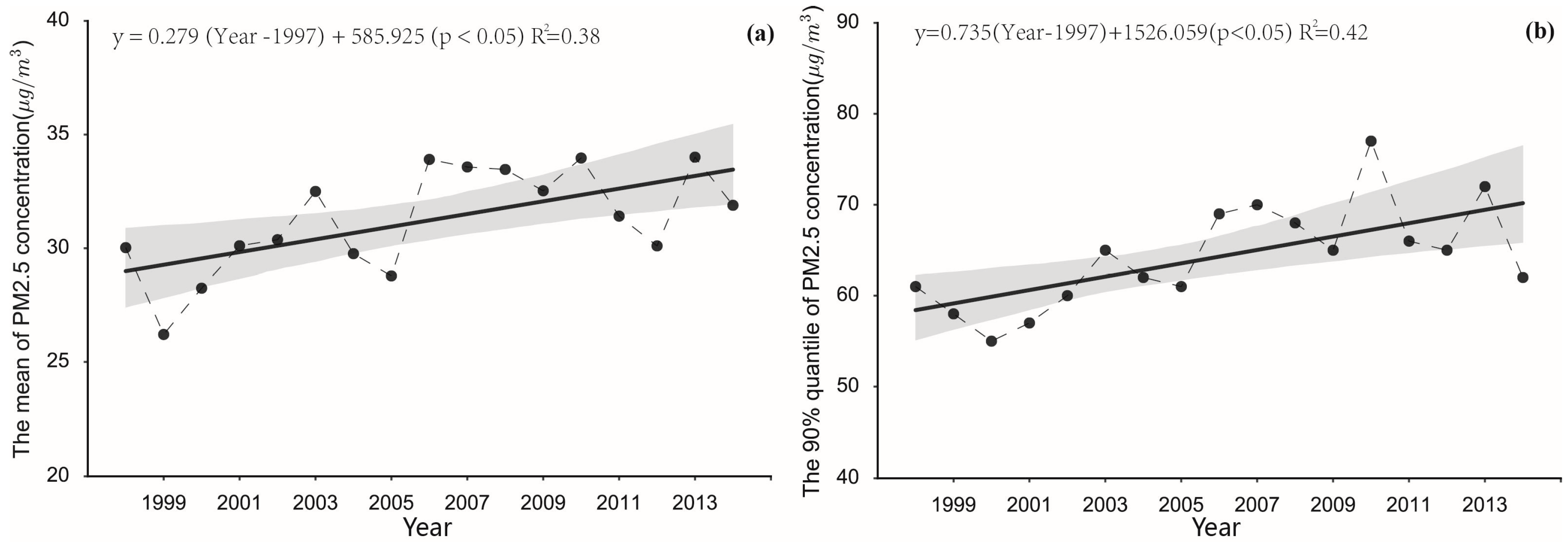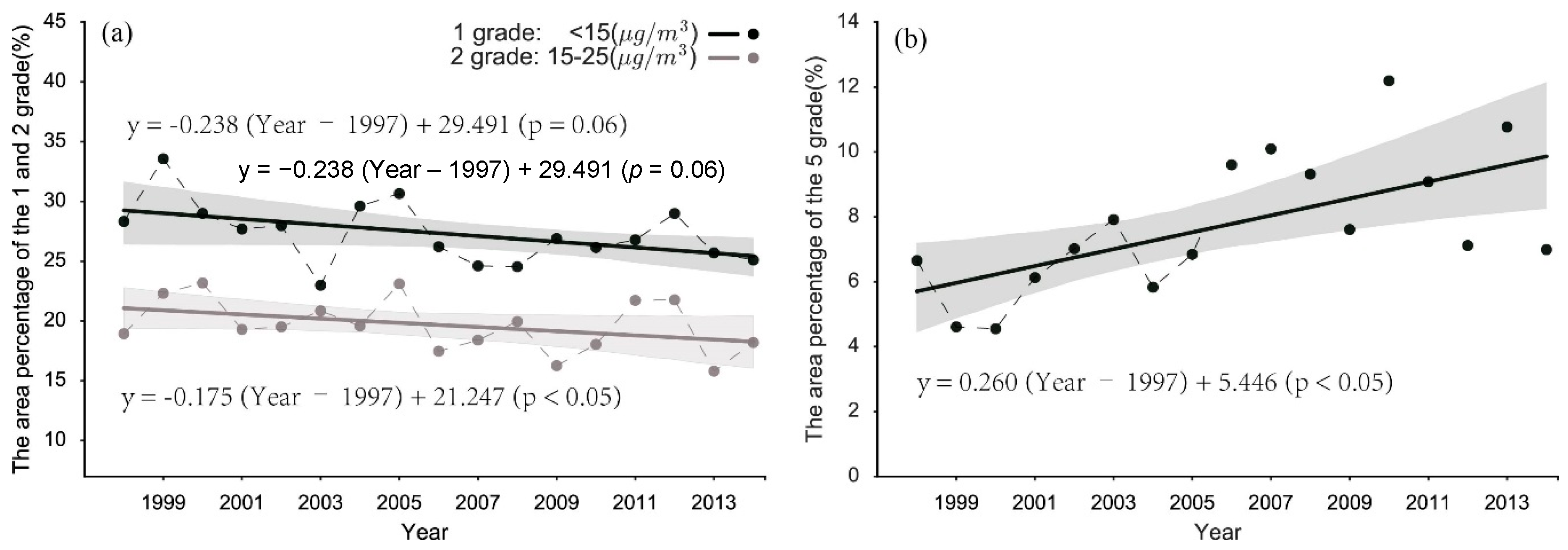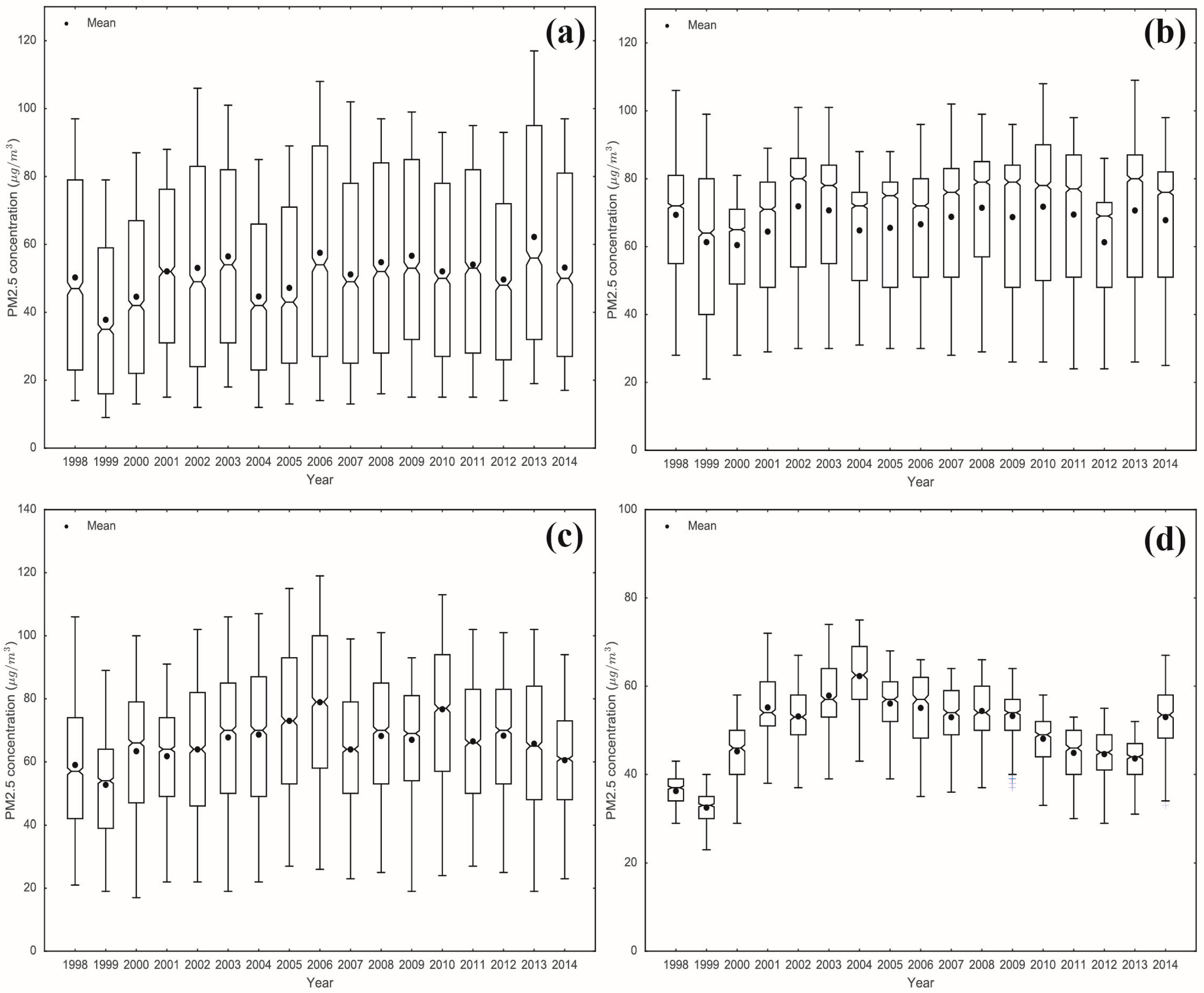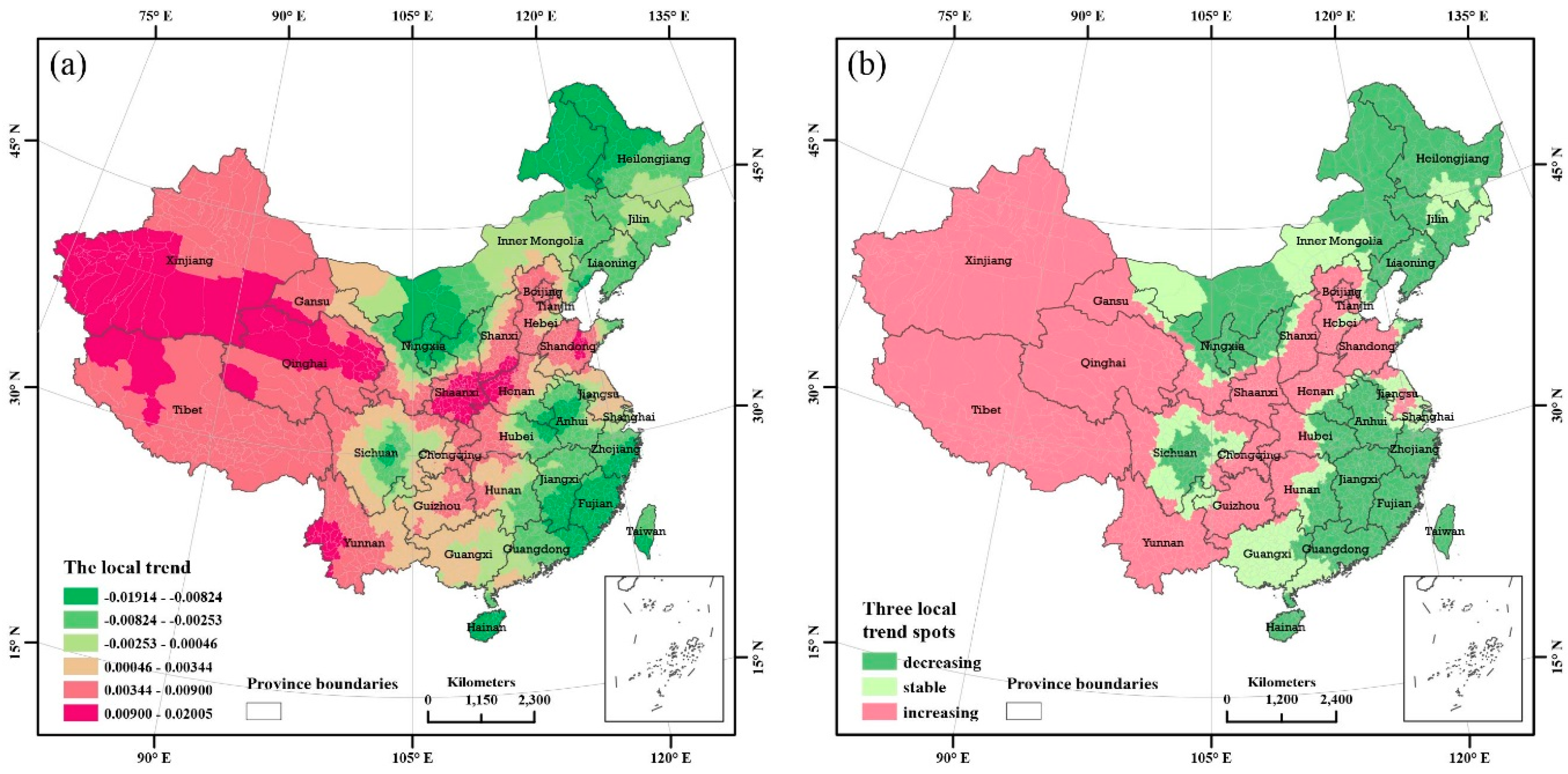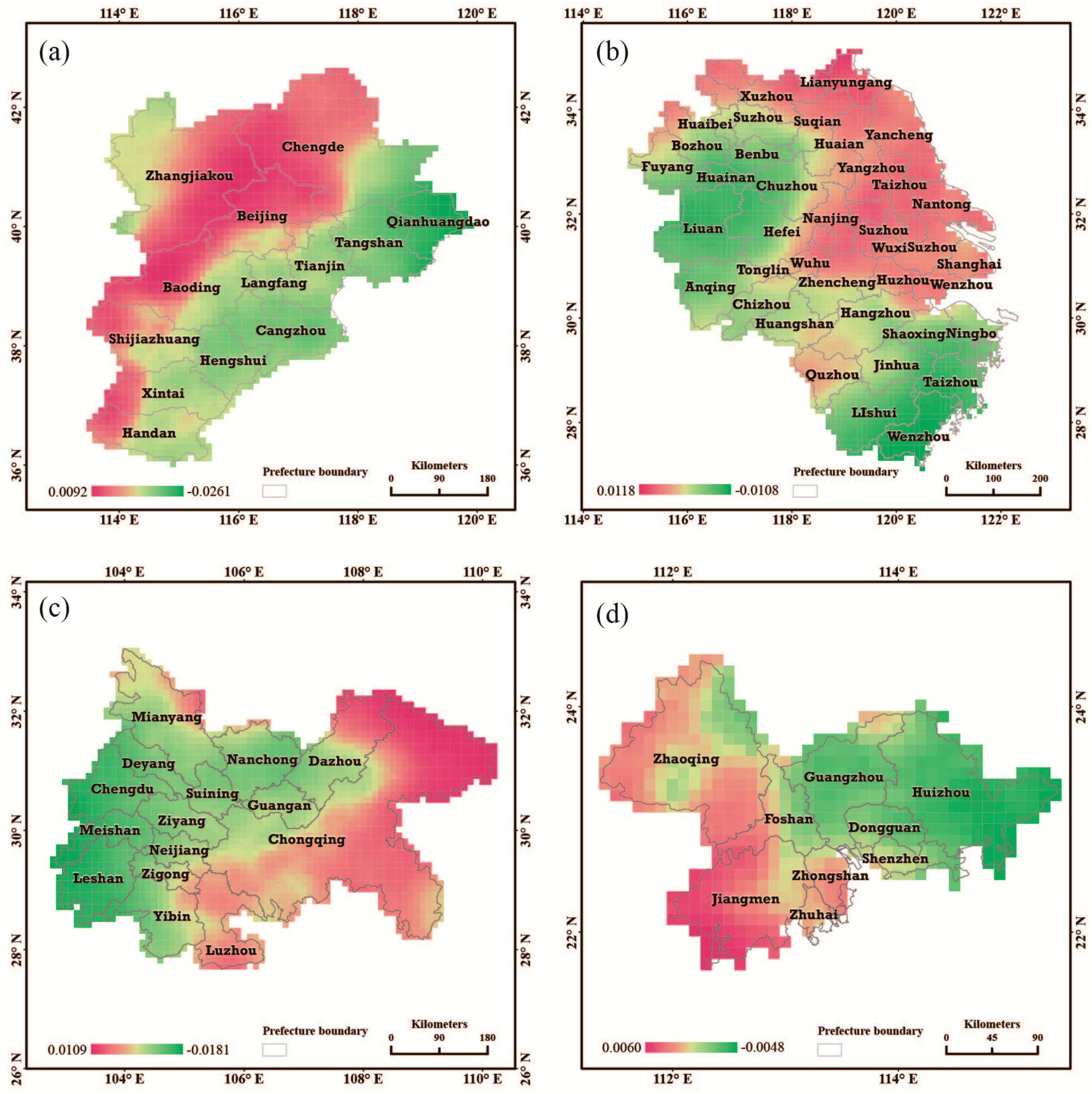1. Introduction
Air pollution has become an important factor that threatens human health. Particulate matter (PM) suspended in the air is regarded as the most severe type of pollutant [
1]. PM with an aerodynamic diameter of less than 2.5 μm (PM
2.5) can enter deeply into the human body through breathing [
2]. Some public health studies have found that PM
2.5 affects public health significantly and adversely [
3,
4,
5,
6,
7,
8,
9,
10,
11]. Chen et al. [
12] reported that a 3-year reduction in average life expectancy and a 14% increase in total mortality would result from a respirable PM concentration increase of 100 μg/m
3. Forouzanfar et al. [
13] reported that PM
2.5 resulted in three million premature deaths worldwide in 2013. Because PM
2.5 can easily enter the human body, thereby causing chronic disease and increasing mortality and morbidity, PM
2.5 has become an important issue in international pollution research [
2]. In recent years, estimating ground-level PM
2.5 concentrations by using satellite-based remote sensing data has become more important for studying long-term changes of PM
2.5 concentrations due to advances in new retrieval algorithms that have led to high accuracy and long-term data stability [
14,
15,
16,
17,
18,
19,
20,
21]. PM
2.5 concentrations estimated from satellite data can fill the gaps in data obtained from fixed sites and result in high-resolution data [
22]. Compared with ground-based site monitoring, remote sensing is capable of quickly obtaining large-scale and spatially continuous PM
2.5 concentrations [
2,
23]. Currently, not enough monitoring stations are available to fully capture the large scale variability of PM
2.5 in China [
11]. PM
2.5 concentrations retrieved by satellites have been used as an effective method for studying the regional distribution and variation of air pollution [
24].
With its industrial development and rapid urbanization, China is facing a challenging environmental pollution problem, particularly haze pollution [
25]. Severe and widespread PM
2.5 pollution in China has raised more and more public concern [
26]. Based on the World Health Organization (WHO) recommendations, Chinese air does not currently meet air quality standards [
27,
28]. In China, ambient PM pollution was the fourth leading risk factor for death in 2010 [
29]. Given the unbalanced development and diversity in China, the PM
2.5 pollution in China likely exhibits strong spatial heterogeneity. If the spatiotemporal patterns of PM
2.5 concentrations in China could be accurately determined, the resulting knowledge could be used to prevent and control PM
2.5 pollution. In this paper, the spatiotemporal variations of PM
2.5 in China from 1998 to 2014 are explored. Few researchers have studied the spatiotemporal patterns of PM
2.5 concentrations in China. Lin et al. [
10] studied the spatiotemporal variations of PM
2.5 concentrations in China from 2001 to 2010 by using the global annual average PM
2.5 grids data from the Battelle Memorial Institute and the Centre for International Earth Science Information Network/Columbia University. Ma et al. [
28] estimated the PM
2.5 concentrations from 2004 to 2013 in China from MODIS remote sensing data and briefly discussed the spatiotemporal trends of the PM
2.5 concentrations. Peng et al. [
2] systematically investigated the space-time patterns of PM
2.5 concentrations in China from 1999 to 2011 using a resolution of 10 km and PM
2.5 data retrieved by van Donkelaar et al. in 2015 based on classic statistical methods [
30].
To our knowledge, we are the first to employ a space-time Bayesian hierarchy model to analyse the spatiotemporal variations of PM
2.5 concentrations. The remotely sensed PM
2.5 data used in the paper were obtained from the latest versions of the datasets from 1998 to 2014, which were estimated by van Donkelaar et al. [
31]. In addition to the national scale, four leading urban areas in China have been studied. The objective of this study is to systematically explore spatiotemporal variations and trends in PM
2.5 concentrations that can be used by Chinese policymakers or others to prevent or reduce PM
2.5 pollution.
3. Results
3.1. Preliminary Statistics
The spatiotemporal patterns of PM
2.5 concentrations across China over 17 years (from 1998 to 2014) are illustrated in
Figure 2. During the study period, a steady spatial PM
2.5 concentration distribution formed a “3-Clusters” pattern. The “3-Clusters” represent three areas: the Tarim Basin located in the northwest of Xinjiang Province, the Sichuan Basin located in the southwest, and the North China Plain containing the Jingjiji urban group and Shandong Province. The “3-Clusters” regions had high levels of PM
2.5 pollution, especially the Sichuan Basin and the North China Plain, which have always had the highest pollution levels in China from 1998 to 2014 (17 years). Regarding the temporal trends in PM
2.5 pollution, the mean and 90% quantile of the PM
2.5 concentrations in China generally maintained a statistically significant increasing trend according to the liner regression statistical analysis shown in
Figure 3, with increments of 0.279 μg/m
3 (95% CI: 0.083–0.475) and 0.735 μg/m
3 (95% CI: 0.261–1.210). The mean minimum and maximum PM
2.5 concentrations in China occurred in 1999 and 2010 and were 26.2 μg/m
3 and 33.97 μg/m
3. Five local peaks in the PM
2.5 concentrations occurred in 1998, 2003, 2006, 2010, and 2013 during the 17 considered years. In contrast, the PM
2.5 concentrations were lower in 1999, 2005, and 2012. A large increase was observed to occur from 1999 to 2003, with an increase from 26.2 μg/m
3 to 32.50 μg/m
3. The maximum yearly increase from 28.78 μg/m
3 to 33.91 μg/m
3 occurred from 2005 to 2006. During 2006–2010, the mean PM
2.5 concentration over China remained high, with concentrations of between 32.53 μg/m
3 and 33.97 μg/m
3.The 90% quantile trend is roughly similar to the mean trend. Integrating the mean and 90% quantile trends showed that the pollution concentrations in China were higher in 2006, 2007, 2010, and 2013.
Figure 2 shows that the “3-Clusters” regions all had higher PM
2.5 concentrations in 2006, 2007, 2010, and 2013.
In addition to the mean and 90% quantile, we investigated the variations of the histograms showing the distribution and gradient of PM
2.5 concentrations over China.
Figure 4a shows the temporal variation of PM
2.5 in a time histogram, where each row represents the corresponding histogram of PM
2.5 concentrations, and the small squares with different colors reflect different frequencies. Although the annual average PM
2.5 concentrations over China were mainly distributed from 26.20 to 34.00 μg/m
3, the area proportion with different PM
2.5 concentrations grades varied year by year as shown in
Figure 4b, meanwhile the linear regression result as shown in
Figure 5 demonstrated it. The classification of PM
2.5 concentrations in this paper primarily refer to the WHO Air quality guidelines for particulate matter [
44] and the specific conditions in China. The statistical results explained that the percentages of the areas with PM
2.5 pollution grades of 1 and 2 were <15 μg/m
3 and 15–25 μg/m
3 and roughly decreased, as shown in
Figure 5a. In addition, the annual decreasing rates were approximately 0.238 and 0.175 percentage points for the areas classified as pollutant grades 1 and 2 respectively, as shown in
Figure 5a. Nevertheless, the highly polluted area, grade 5, with concentrations of >70 μg/m
3, increased significantly at an annual rate of 0.260 percentage points, as shown in
Figure 5b.
The temporal variations of the PM
2.5 concentrations in the four urban groups in the Jingjinji, Yangtze Delta, Cheng-Yu, and Pearl Delta in China have their own various features, as shown in
Figure 1.
Figure 6 illustrates differences in the range and temporal trends among the four city agglomeration regions.
The 90% quantile, median, and 10% quantile in the Jingjinji urban group increased from 1998 to 2014. The linear regression results show that the annual increment of the median and 10% quantiles of PM2.5 concentrations in the Jingjinji urban group are statistically significant {0.586 μg/m3 (95% CI: 0.080–1.092) and 0.412 μg/m3 (95% CI: 0.098–0.726), respectively}. Meanwhile, the maximum and minimum PM2.5 concentrations were observed in the Jingjinji and Pearl Delta urban regions, respectively. The spatial heterogeneity of the PM2.5 concentrations was the strongest in Jingjinji. In the Pearl Delta urban group, the spatial difference between the PM2.5 concentrations was small. However, the strong increase in the PM2.5 concentrations peaked in this region from 1999 to 2004 and then slowly decreased. The remaining two urban group regions, Yangtze Delta and Cheng-Yu, experienced stable and stochastic PM2.5 concentration fluctuations.
3.2. Bayesian Estimation over China
The spatial local magnitudes of PM
2.5 pollution relative to the overall magnitude of PM
2.5 pollution in China were estimated using the space-time Bayesian hierarchy model employed in this paper.
Figure 7 shows the estimated results and the spatial patterns at the country and district level. In this paper, six different categories are classified, as shown in
Figure 7, according to the local magnitude of the PM
2.5 pollution relative to the overall magnitude of the PM
2.5 pollution based on the geometric interval method. The three areas marked in green and pale yellow represent areas with lower pollution, and the other three areas marked by deep yellow and red represent areas that are considered highly polluted.
The areas with high local PM
2.5 pollution magnitudes relative to the overall PM
2.5 pollution magnitude cover 1679 counties and districts, with a population of 949 million, which accounted for 69.3% of the total population based on the 6th National Population Census. Highly polluted areas in China have distinct spatial structures and strong spatial aggregation. Most of the pollution is distributed in one large continuous area and three small areas. The most and second most polluted regions are located in a large and continuous area in two independent spatial clusters. The most polluted areas form an equicrural triangle and circle, which is marked by dark red in
Figure 7. Moreover, the highly polluted area revealed a concentric ring gradient geometry with higher concentrations in the centre and lower concentrations toward the edges, as shown in
Figure 7.
Furthermore, the local magnitudes of PM2.5 pollution in the most seriously polluted areas were more than 1.80 times the overall magnitude of PM2.5 pollution in China; thus, in these regions, the PM2.5 pollution concentrations were more than 1.8 times the national total concentrations. Among these regions, east China covers a wide area that includes five provinces: Hebei, Shandong, Henan, Jiangsu, and Anhui. In addition, a concentrated region shaped like an equicrural triangle centred within the boundaries of Shandong, Jiangsu, Anhui, and Henan province formed during the 17 investigated years of 1998–2014. This area has very important meaning regarding economic geography because it is located between two developed urban groups: the Jingjinji urban group that includes Beijing and the Yangtze Delta urban group that includes Shanghai. Regarding geometry, two megalopolises, one consisting of Beijing and Shanghai and one consisting of Zhumadian, an industrial city in Henan Province, formed the highly polluted area, which covers an area in the shape of an equicrural triangle with three vertices. The highly polluted areas involved 448 counties and districts with a population of approximately 287 million, which was calculated from the 6th National Population Census and accounted for 21.0% of the total Chinese population.
The Sichuan Basin is the most polluted region in China. The pollution in this region is probably related to the bowl-shaped topography of the basin. The highest spatial range of pollution in the Sichuan Basin is circular, which is consistent with the bowl-shaped geometry of the basin. The region includes 73 counties and districts, with a total population of 46.70 million [
34]. The Sichuan Basin covers an area shaped like a concentric ring, with a gradient of high to low pollution extending from the centre to the outer edges of the ring. The area can be divided into three concentric gradient rings, with the innermost circle covering the area with the highest pollution, the second ring covering the area with the second highest pollution, and the third ring covering the area with the lowest pollution. In central Hubei there are 18 counties and districts with a local PM
2.5 pollution magnitude of more than 1.80 relative to the overall PM
2.5 pollution magnitude. However, the economy is not developed and the population is not dense in Xinjiang, potentially due to its basin topographic features. Overall, 24 counties and districts exhibit PM
2.5 pollution levels higher than the national total, and 7 of these counties have local PM
2.5 pollution magnitudes that commonly exceed 1.40 times the overall PM
2.5 pollution magnitude.
In addition to the estimations of the spatial local magnitude of PM
2.5 pollution relative to the overall magnitude of PM
2.5 pollution, the STBHM employed in this paper simultaneously estimates the local trends of PM
2.5 concentrations in each country and district. The local trend is measured by the posterior estimation of the
parameter used in the model in this paper. We can distinguish the local trends as follows: (a) a faster increasing trend than the overall trend when the posterior estimated median is
> 0 and the posterior probability is
; (b) a decreasing trend relative to the common trend when the posterior estimated median is
< 0 and the posterior probability is
, and (c) a stable trend when the posterior estimated median is
0 and the posterior probability is
and is between 0.2 and 0.8.
Figure 8a,b show the estimated local spatial patterns of the PM
2.5 concentrations in China from 1998 to 2014. Based on the Bayesian estimates of the local trends, we observed that the regions with faster increases than the overall trend covered the large area shown in pink in
Figure 8b. In western, eastern, and central China, faster increasing local trends were observed. Specifically, the most polluted area in eastern China, which borders Hebei, Henan, Shandong, and Anhui, shows a faster increasing local trend. Meanwhile, the Xinjiang Tarim Basin area has higher PM
2.5 pollution and exhibits a faster local trend of increasing pollution. Hence, these two areas should be targeted for preventing and controlling PM
2.5. In addition, the areas bordering Shannxi, Shanxi, and Henan have experienced strong and local increasing pollution trends.
3.3. Bayesian Estimations for the Urban Groups
The spatiotemporal variations of the PM
2.5 concentrations in four urban groups, Jingjinji, Yangtze Delta, Cheng-Yu, and the Pearl Delta urban group, were estimated using the Bayesian hierarchy model in the paper.
Figure 9 shows the estimation of the spatial local magnitude of PM
2.5 pollution relative to the overall magnitude of PM
2.5 pollution for the areas of the four urban groups in China. For different urban groups, the spatial pattern with relative PM
2.5 concentrations vary. In the Jingjinji and Yangtze Deltas, the PM
2.5 concentration distribution distinctly varied from north to south. Nevertheless, in the Cheng-Yu and Pearl deltas, the spatial differentiation radiated outward from the centre. Furthermore, the spatial heterogeneity of PM
2.5 pollution is highest in the Jingjinji urban group, with minimum and maximum estimated spatial local magnitudes of PM
2.5 pollution of 0.39 and 2.11 relative to the overall magnitude of PM
2.5 pollution, respectively. The remaining three urban groups have approximately the same degree of PM
2.5 pollution heterogeneity.
The regions in the Jingjinji urban group with severe PM2.5 pollution are largely located in the southeast. Four cities, Hengshui, Cangzhou, Xintai, and Handan, have the highest PM2.5 pollution. Regarding the geographic location, the pollution of PM2.5 in Tianjin is more severe than the PM2.5 pollution in Beijing when considering the annual average. For Beijing, the spatial pattern of PM2.5 pollution is similar to the whole region. In the urban group, Chengde and Zhangjiakou experienced relatively lower PM2.5 pollution. In the Yangtze Delta urban group, the northeast region, including Shanghai, has relatively higher PM2.5 concentrations. The five cities located north of the border, Xuzhou, Suzhou, Huaibei, Bozhou, and Fuyang, have the relatively highest PM2.5 concentrations. The areas south of Anhui province and Zhejiang province had relatively lower PM 2.5 concentrations. In the Cheng-Yu and Pearl Delta urban group areas, the regions polluted with higher concentrations of PM2.5 were located in the centres of the two areas. Four cities in Cheng-Yu, Chengdu, Ziyang, Meishan, and Neijiang had the highest concentrations of PM2.5 pollution. In the megacity, Chongqing, which is located in the western region of China and borders highly polluted cities, high concentrations of PM2.5 were observed. One of the three areas with the highest PM2.5 concentrations in China is located in the Cheng-Yu urban group area. The structural and gradually changing spatial pattern of the PM2.5 concentration distribution from the centre of Foshan City and outward to the Pearl Delta urban group was formed.
To investigate the local temporal variations of PM
2.5 concentrations in the four urban groups, we estimated their local trends by using the Bayesian model in the paper. The estimated results are shown in
Figure 10. As described in the methodology section, if the posterior median of the local trend parameter
is greater than 0, the local trend increases faster than the overall trend over the study area. For the estimated results shown in
Figure 9, greater increases of
above 0 correspond with relatively faster local increases in one urban group area. In the Jingjinji, Cheng-Yu, and Pearl Delta urban group areas, cities with less pollution have inversely higher local increasing trends. Nevertheless, 18 cites, including Shanghai and Nanjing in the urban area of the Yangtze Delta, have experienced not only high PM
2.5 concentrations but also faster increasing local trends. In other words, these regions will continue to deteriorate if air pollution is not controlled. Thus PM
2.5 pollution should be prevented and controlled in these 18 cities.
4. Discussion
The latest PM
2.5 concentrations derived from satellite by van Donkelaar et al. [
31] were used in this study. Multiple types of satellite remote sensing data, e.g., MODIS Dark Target, MODIS MAIAC, MODIS and SeaWiFS Deep Blue, and MISR, were integrated to produce this dataset. The estimated PM
2.5 results are highly consistent, with R
2 = 0.81 for out-of-sample cross-validated PM
2.5 concentrations from 4082 monitoring points [
31]. In North America, East Europe, and Central Europe, low levels of uncertainty with bias of −0.7 to 0.4 μg/m
3 compared with the monitored PM
2.5 concentrations were observed. In Latin America and parts of Asia, relatively high uncertainty occurred, with bias of up to 11.6 μg/m
3 [
31]. Considering the high PM
2.5 concentrations in China, the maximum PM
2.5 concentration was 117 μg/m
3, and the precision of the satellite-retrieved PM
2.5 concentrations was reasonable in scope. Furthermore, Peng et al. [
2] confirmed the accuracy of the previous data produced by van Donkelaar for the specific area of China. Peng et al. [
2] indicated that the correlation coefficient of remotely sensed PM
2.5 concentration data against the PM
2.5 concentration monitored in-situ was 0.79 in China, and the distribution of the residuals’ cumulative probability was random.
China not only has a large population, but also a high population density with unbalanced development. The risk of exposure to PM2.5 is particularly prominent in China. Considering that the demographic grid data from 2000 to 2010 was based on the 5th and 6th Chinese Population Census and was more reliable, we selected the population grid data in 2000 and 2010 to discuss exposure to PM2.5 in China. According to the statistical results, the increases in the percentage of exposure to PM2.5 concentrations greater than 100 μg/m3 and 70 μg/m3 were the most significant. In 2000, the PM2.5 concentration in China did not exceed 100 μg/m3; however, the percentage of the population exposed to PM2.5 concentrations greater than 100 μg/m3 was 5.1% in 2010. The percentage of the population exposed to PM2.5 concentrations greater than 70 increased from 23.4% in 2000 to 39.6% in 2010. The exposure ratios of the other PM2.5 concentration gradients maintained a relatively stable status. The exposure percentages to PM2.5 concentrations greater than three with target WHO concentrations of 35 μg/m3, 25 μg/m3, and 15 μg/m3 were 81.1%, 91.6%, and 98.1% in 2000, and 82.0%, 91.2%, and 98.9% in 2010, respectively.
The results in the paper are some different from those of previous studies. Generally, the PM
2.5 concentrations across China determined in this paper are lower than those determined in studies conducted by Peng et al. [
2] and Ma et al. [
28]. However, the proportion of the area with PM
2.5 concentrations of less than 15 μg/m
3 is lower than the proportion observed by Peng J.’s, with a difference of −11.3% in 1999 and −7.4% in 2011. The area proportions of the middle PM
2.5 concentrations of 25–35 are different, with 4.9% in 1999 and −0.6% in 2011. The locations with high PM
2.5 pollution detected by STBHM in this paper are roughly consistent with those identified in previous studies. Based on the overall and local trends, we have drawn various conclusions. The estimated results in this paper indicated that the PM
2.5 concentrations over China generally increased from 1998 to 2014, while Ma et al. [
28] identified two stages, an increasing stage from 2004 to 2007 and a decreasing stage from 2008 to 2013. The estimates in our study suggested that the entire western area experienced a local increasing trend. Peng et al. [
2] noted that only the Xinjiang area showed a gradually increasing local trend and that the remaining regions in the western area maintained a stable local trend.
Considering the topographic features, “3-Clusters” belonged to a local low-lying area, indicating that the annual average PM
2.5 concentration is related to regional terrain characteristics. In Low-lying areas, PM
2.5 generally aggregates easily, while the impact of regional wind appears weaker in terms of the entire year. The Sichuan Basin and the North China Plain regions have higher population densities. We suspect that the PM
2.5 concentration is also related to population density. Han et al. [
45] illustrated a significant correlation between PM
2.5 concentration and population in Beijing.
The PM2.5 concentrations in China showed a statistically significant increasing trend, with increments of 0.279 μg/m3 (95% CI: 0.083–0.475) and 0.735 μg/m3 (95% CI: 0.261–1.210). The areas with low PM2.5 pollution are shrinking, while the areas with high PM2.5 pollution are expanding. These changes suggest that the environmental governance in China should be continuously strengthened. The areas of focus are the North China Plain and the Sichuan Basin regions, which have high PM2.5 concentrations and the same populations. Based on Bayesian estimations, the areas with the most severe pollution, with a common spatial relative risks of more than 1.0, covered 1679 counties or districts and affected a population of 949 million people, accounting for 69.3% of the total population. The western, eastern, and central regions of China all exhibited faster increasing local trends than the overall trend. It should be noted that the North China Plain regions have high PM2.5 pollution levels and exhibit increasing local trends. In other words, the PM2.5 pollution in the North China Plain regions can be expected to further deteriorate if no effective preventative measures are implemented. Although the western regions in China have lower PM2.5 pollution levels, increasing trends have been occurring.
This paper primarily focused on the spatiotemporal variations of PM2.5 pollution in China in four large urban areas and has the following limitations. First, on-site monitored PM2.5 concentration data were not used in this study. The research results from our study are based on remotely sensed PM2.5 concentrations. If remote sensing inversion and on-site measured data are integrated together, the results will be more reliable. Second, because the STBHM requires heavier computation, the county-level or district-level administrative regions were considered as a statistical unit when detecting the spatiotemporal variability of the PM2.5 concentrations at the national scale. Thus, the average pooling process had to be executed before calculation, which could add some uncertainty. Third, this paper mainly focused on the space-time variability of PM2.5 concentrations and did not provide the influencing mechanism of PM2.5 pollution. However, we hope that this paper provides new insights for considering PM2.5 pollution. In the future, we will collect data from more PM2.5 data sources, e.g., on-site monitoring data, to continue studying the dynamic process of PM2.5 pollution based on multi-source data. In addition, promoting the efficiency of the STBHM for applications with remote sensing pixel data is an important area for future research, and the influencing factors and mechanisms of PM2.5 pollution should be an important area of concern.
5. Conclusions
The spatiotemporal patterns and trends of PM2.5 concentrations in China during 1998–2014 are analysed in this paper. The related remotely sensed dataset is the latest version of the inverted data produced by the team lead van Donkelaar. First, STBHM is employed to analyse the spatiotemporal variations of the PM2.5 concentrations in China from 1998 to 2014. Meanwhile we briefly discussed the status of the exposure to PM2.5 concentrations at the national level. Our study primarily arrived at the conclusions presented below:
Generally, a steady “3-Clusters” spatial pattern of high PM2.5 pollution formed. The “3-Clusters” areas, the Tarim Basin region located in the northwest, the Sichuan Basin region located in the southwest, and the North China Plain containing the Jingjiji urban group and Shandong Province, experienced higher PM2.5 pollution, particularly in the latter two cluster regions.
Different large urban areas showed different spatial PM2.5 pollution structures, with the northern and southern areas showing differences in the Jingjinji and Yangtze Deltas and a circular PM2.5 concentration gradient in the Cheng-Yu and Pearl Deltas. The spatial heterogeneity of the Jingjinji urban group was the strongest. The 18 cities, including Shanghai and Nanjing in the Yangtze Delta urban group area, experienced high PM2.5 concentrations and the fastest increasing local trends simultaneously. These 18 cities have recently become more developed over China but have resulted in environmental pollution problems. The developed industrialized cities that experience high PM2.5 pollution should implement industry transformations.

